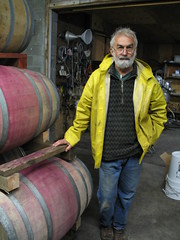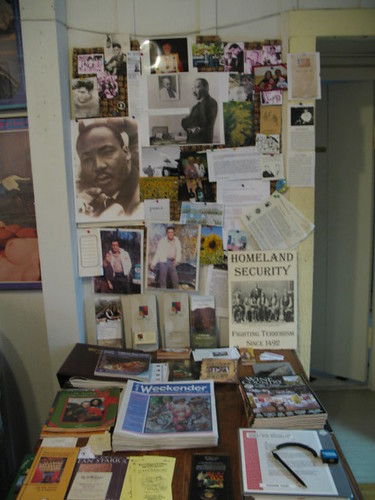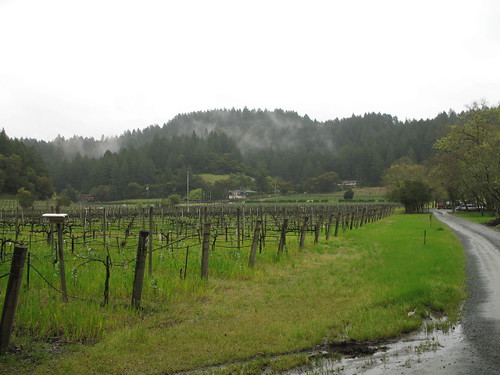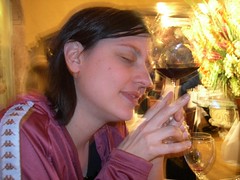Casa Nuestra Winery: Off the beaten Silverado Trail
 Allen Price and I arrived at the front of the little yellow tasting room at Casa Nuestra winery at the same time, both in rain gear, and both probably equally annoyed at the persistence of this unseasonable downpour. "This stuff is supposed to be over British Columbia this time of year," he says as we quicken our pace toward the cellar. "It's a fluke. Some think it's global warming, but that's only part of it. I've seen it happen before."
Allen Price and I arrived at the front of the little yellow tasting room at Casa Nuestra winery at the same time, both in rain gear, and both probably equally annoyed at the persistence of this unseasonable downpour. "This stuff is supposed to be over British Columbia this time of year," he says as we quicken our pace toward the cellar. "It's a fluke. Some think it's global warming, but that's only part of it. I've seen it happen before."This guy is both a dyed-in-the-wool farmer and a bonafide Napa townie, so I'm guessing he knows what's up with the weather. During my entire trip, I've asked if this early rain will have much of an effect on the vines, and only Price has said anything but "Nah, they're dormant". He takes a moment to explain that many of the vines, like some people, take a look at the cold rain and think, "To hell with that," and stay asleep until things look less nasty. This can shift the growing season to a later schedule, and while it doesn't bother the vines now, it can cause harvest to get pushed dangerously close to the October rainy season. Now that can be bad.

We moved it inside to the tasting room, which is of itself worth the stop. It used to be open on a regular schedule, but has now been moved to appointment only. Price and I sat down at a table surrounded by posters and chatted while a passionately affectionate black lab demanded her share of attention.
Interview with Allen Price, Casa Nuestra Winery
C & D: You've been here most of your life, and you were talking earlier about some of the changes you've seen, economically and so on, that have gone on in the Napa Valley. Can you talk more about that?
Price: Yeah. Used to be a depressed area, used to be grape farms all around the valley floor, into Rutherford, where it gave way to pear orchards and apple orchards and prunes. I worked that as a teenager, to begin, and there wasn't much money in it, wasn't much money in grapes either. My grandparents just about starved on forty acres in St. Helena.
What year was that?
In the fifties. The area always made good wines, from red varieties, especially. The area got involved in the revision, the urban revision, and people started moving into the area, replanting what were seen as "better" varieties...Chardonnay and Cabernet. And that trend continues to evolve, into the present.
How long have you been here with Casa Nuestra?
Four years, but I helped assemble this place in 1979. Spent most of my life working for Hess Collection and other wineries before that. In Sonoma.
So you've been making wine for how long?
Oh, off and on for...thirty five years? Off and on. I've had other jobs. I've been a plant engineer, outfitted equipment for wineries...
What appealed to you about making wine?
To me, making wine is like low temperature baking. It's food preparation, except you're working through seasons. Your vineyard block is like having a new baby. You nurture it all year long and then you harvest it, vinify it in the winery, it's a whole process, you can track every step of it.

Casa Nuestra is sort of an anomaly on the Silverado Trail. What sets it apart?
Part of it is that we use older varieties that are well attuned to the site and well suited to the district. That helps a lot. We also know what we're doing with these, have a lot of experience with these particular blocks. And they're properly mature. We have very little under ten years old, some go out to sixty, seventy years. And it takes that long to stabilize the production and to get the best quality.
You've got those old Chenin Blanc vines out there...what happened to Chenin Blanc? Why did it fall out of favor?
So much bad wine was made out of it over many decades, without any attention, made sweet and at the bottom of the cost scale. What we do here is we have a dry-farmed old block that has a small production level, and if we get it right, then it makes really nicely perfumed wine.
What does really good Chenin Blanc taste like to you?
It has a melony mouthfeel with a floral nose, mostly.
Talk a little about what terroir means to you, how it expresses itself, why it's important.
Starting with the ground, the earth...with its water holding potential, and to a certain degree, its mineral composition...we try to set the crop level, or the pound of grapes per vine (to that). The other half is the climate at that site, and also the exposure, these factors all make it unique. If you grow tomatoes, it's the same thing. If you withhold production, if you have properly ripened with good sunlight...if you pay attention to what you're doing, then you can get better wines.
******
Allen Price also makes wine for the David Fulton winery, a family owned operation recently brought back by the retired grandson of the original nineteenth-century owners. They are very small production outfit and specialize in big fat petit sirah. If you're a Cal-style knife-and-fork petit sirah fan, check 'em out.
I've been fortunate since in Napa to meet some very cool people and hang out in their very cool houses. And by cool I don't mean rich. I mean intelligent, witty, fun-loving and ass-whippers at hospitality. Gahd, I love this trip.
Stay tuned, more Napa, Sonoma and outlaying areas to come....
Clinkies.
Stay tuned, more Napa, Sonoma and outlaying areas to come....
Clinkies.





1 Comments:
One of your best pieces yet.
Post a Comment
<< Home